How to Cite | Publication History | PlumX Article Matrix
F. Hassani and N. Gaouar Benyelles
Laboratory of Ecology and Management of the Natural Ecosystems - Tlemcen Algeria
ABSTRACT: In order to struggle efficiently against the phytophag Ceratitis capitata (Wied) that is the cause of many important damages on several fruits which partially attacks the citrus fruits, it necessary to know its bio-ecology in our region as well as its natural parasitism, to propose a mean of an efficient struggle with a perfect correlation with its circle of development and its dynamic of population. The importance of this spoiler attacks seem to be influenced by different ecological, biotic and abiotic factors, like the variety, the date of observation, the orientation and finally the tree which have been tested in order to estimate the impact. The adult trappings have permitted to know their dynamics and their breeding which have permitted to obtain the adult to know the sex-ratio, the time of development, the amount of survival and the nature of parasite and its amount of parasitism.
KEYWORDS: Ceratitis capitata (Wied.); Citrus sinensis; Opius concolor
Download this article as:| Copy the following to cite this article: Hassani F, Benyelles N. G. Bio-ecology of the Mediterranean fruits fly Ceratitis capitata (Wied) (Diptera: Tephritidae) in the area of Tlemcen, Algeria. Biosci Biotechnol Res Asia 2008;5(1) |
| Copy the following to cite this URL: Hassani F, Benyelles N. G. Bio-ecology of the Mediterranean fruits fly Ceratitis capitata (Wied) (Diptera: Tephritidae) in the area of Tlemcen, Algeria. Biosci Biotechnol Res Asia 2008;5(1). Available from: https://www.biotech-asia.org/?p=6418 |
Introduction
Ceratitis capitata (Wied) develops on several fruit-bearing species with a very great adaptation; what does not prevent the influence of various ecological factors on its biology and the size of its population.
We are particularly interested in the incidence of some abiotic factors such as the orientation and the date of observation and the biotic factors such as the effect of the variety and the tree sampled on the attacks of this ravageur. The results obtained confirmed our initial forecasts but with more or less significant impacts.
The captures of adults and the breeding led to the laboratory informed us about the biology of this dipterous in our area, like about its parasitism.
Materials and Methods
We were interested in the study of the most notorious ravager of the citrus fruits Ceratitis capitata (Wied), because of the significant damage that it causes, particularly in the area of Tlemcen or arboriculture occupies a major place with a surface of 1960 ha citrus fruits. This phytoparasit is studied in the area “of El Fehoul” while following on ground its attacks on two varieties of citrus fruits according to:
Orientation of the attacks on the fruits;
The date of sampling, which gives us the temporal distribution of the attacks;
The space distribution of the attacks of the ravager on the trees;
Variety of citrus fruits considered;
In addition breeding carried out at the laboratory enable us to estimate the rates of emergence of the imagoes, their sex-ratio, the durations of development of the various stages like their rate of survival and mortality and the nature of the parasite.
Two varieties of orange were selected for the availability in great number of their fruits during all the period necessary to the realization of the taking away:
We thus chose a grid of 3 trees out of 3 to carry out our systematic sampling, which enabled us to carry out our nine taking away. According to Debouzie and al..(1987);Gaouar and Debouzie (1995);and Gaouar (1997), systematic sampling is ready to detect the space and temporal structures attacks of the ravagers.
On the level of each tree, the fruits are examined and the punctures counted for the four orientations (north, south, east and western). This examination is practiced on five infested fruits not dropped by orientation for each tree; a total of twenty fruits not dropped by tree is sampled.
Those found by ground, are put in sachets and transported at the laboratory to be put in breeding.
To know the type of parasitoid which exists within the two orchards (Valencia late and Washington navel) we let us be limited to the study of the dropped fruits since they lost their commercial value, the not dropped fruits being intended for marketing. The method of breeding at the laboratory is simple, it consists in putting oranges in basins containing of sand to allow the hiding of the nymphs and the larvae resulting from these fruits. A wet sponge ensures the hygroscopy necessary to the development of these stages of the insect.
Results and Discussions
The rates of infestation of the fruits are estimated starting from the number of holes of big shot entered on oranges, in situ. We have chosen two varieties Valencia late and Washington navel.
At the variety Valencia late, the rates of infestation are similar for the different orientation Fig. -1.
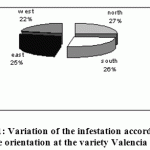 |
Figure 1: Variation of the infestation according to the orientation at the variety Valencia late.
|
North ¾¾® 2, 38, South ¾¾® 2, 51, West ¾¾® 2, 16, east ¾¾® 2, 37 what is confirmed by ANOVAs which gives Fobs = 0.38 for P=0.767.
The Effect of the date of observation is fort present because the variations inter-dates are very significant with Fobs = 5, 99 for P = 0,000. There is a variation of the number of holes of laying per month and date of sampling.
In the orchard of Valencia late, the infestation reaches its maximum in December, and starts to decrease as of January to on reach its lowest rate for the four orientations January 25, 2004.
The kinetics of the infestations by date presents two peaks Fig. -2, corresponding to maximum infestations.
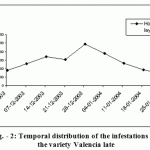 |
Figure 2: Temporal distribution of the infestations at the variety Valencia late.
|
The tree have also a significant difference of the averages, with Fobs = 3, 48 for P = 0,000, therefore the tree affects great the attacks of C. capitata.
The infestation of the fruits of the variety Valencia late, seems subjected to the effect of the tree, which had mainly with phenology, with the intrinsic factors such as the volatile substances which it releases as with its space position in the orchard since often the trees located at the edges of the orchard are attacked since in fact the first intercept the flies coming from the close orchards.
In the variety Washington navel the average rates of infestation vary from one orientation to another.
In north ¾® 2, 26 in south ¾® 3, 12 in west ¾® 4, 28 in the east ¾® 1, 29.
The variance analyses confirm these variations since for this variety the orientation has a highly significant incidence with Fobs = 71, 90 for P = 0,000.
The variety Washington navel shows a preference of attack by the fly from one orientation to another.A more significant infestation is noted with the western exposure, then southern, then northern and finally is Fig. -3.
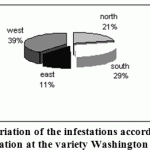 |
Figure 3: Variation of the infestations according to the orientation at the variety Washington navel.
|
The date influences the infestations with Fobs significantly = 5.76 for P = 0.000.
The variety Washington navel presents a very irregular variation of the holes of laying throughout the period of study, but always with a lower value for the last date of sampling. The kinetics of the infestations by date shows that there are two peaks well nets Fig. -4.
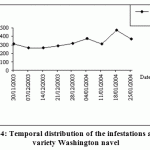 |
Figure 4: Temporal distribution of the infestations at the variety Washington navel.
|
There is a highly significant difference of the averages for the factor “tree” with Fobs = 4, 56 for P = 0,000.
The results obtained show that the tree has a great effect on the infestation of the fruits of Washington navel, which is a variety characterized by its powerful odor, and it gauge its fruits, thus attracting the fruit flies, in particular Ceratitis capitata.
To show the impact of the variety, we carried out a variance analysis to a controlled factor, including the two varieties to be studied.
This analysis reveals a highly significant difference which confirms the incidence of this factor on the infestation of the fruits by Ceratitis capitata at the two varieties, Valencia late and Washington navel with Fobs = 2, 26 for P = 0,000 Fig. -3.
On the biology of the population of Ceratitis capitata starting from the breeding, the major interest of the breeding it is that it makes it possible to know the durations of larval development and nymphal of the ceratite as well as the dates of appearance of the imagoes, the sex-ratio ratio and the duration of their survival in conditions of laboratory.
Whatever the variable considered the rate of infestation changes each time with the studied variety. The larval pressure in a fruit induces an intraspecific competition, the most active larvae and largest will result in the death of weakest Fig. -5 and Fig. – 6.
The same breeding also made it possible to know the duration of the nymphose and mortalities pupales Fig. -5 and Fig. – 6.
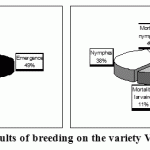 |
Figure 5: ¶Results of breeding on the variety Valencia late.
|
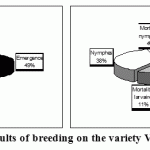 |
Figure 6: Results of breeding on the variety Valencia late.
|
The results of breeding showing that the emergence of the adults on the two varieties were always variable, it seems related to the biochemical composition of the fruit since earlier Washington navel, is richer in sugar during the critical periods of the stages larvaires Fig. -5 and Fig. -6. The sex-ratio is practically equivalent for the two sexes.
From the economic point of view, the ceratite damages the quality of orange, which is reflected on the cost and the marketing of its fruits very appreciated by the consumer.
In the two studied orchards, the percentages of infestation due to the punctures are represented in Fig.-7.
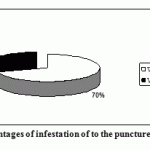 |
Figure 7: Percentages of infestation of to the punctures.
|
The attacks of the ceratite on citrus fruits seem to be influenced by the various factors which we chose to test during this present work; that one considers the holes of laying or the numbers of dropped fruits, the results remain similar.
A variance analysis to a controlled factor, including the two varieties to be studied
reveal a highly significant difference which confirm the incidence of this factor on the infestation of the fruits by Ceratitis capitata at the two varieties, Valencia late and Washington navel.
The statistical tests carried out starting from the fruit samples observed and dissected indicate that the varieties of the most infested Citrus sinensis are “Valencia late” and “Washington navel”.
We allotted these differences of infestation between the two varieties primarily to the skin of the orange whose color, thickness and the chemical composition are variable. It seems that the varieties with fine skin are attacked as those whose color transfers towards the yellow, attracting Tephritidae as Nakagawa and al., (1978); Katsoyannos (1987) showed that the yellow color and the degree of maturity of the fruit can play a role for the attraction of the cératite.
Haisch and Levinson (1980); Dhouibi and al., (1995) Naâmani and al., (1997) explain this attractivity by several factors of which mainly the sugar whose content increases maturity of the fruits progressively.
The two studied varieties present infestations which vary significantly according to dates’ of taking away. Indeed, the infestation of citrus fruits evolves/moves in time with the degree of maturity of the fruits. Naâmani and al., (1997) indicate that the increasing maturity of the fruits stimulates the activity of the flies; they are the climatic conditions and the harvest of the fruits which stop it.
The variations inter-dates are very significant they prove that the infestation at the variety Valencia late, the most attacked, gradually increases first date of taking away at the sixth date. Similar results were found at Washington navel. After the sixth date, the strong falls of temperature inhibited the layings.
According to several work, the females carry out their laying during the hottest hours and on with dimensions the sunniest of the tree (Bodenheimer, 1951; Féron, 1962; Bernstein 1986; Hendrichs and al., 1989).
The orientation of the fruits in a tree seems to have a certain influence on the attacks of Ceratitis capitata; the results obtained agree to show that the orientation influences the infestations significantly, the south and the west being attacked than north and is for the two studied orchards.
These same results were obtained by Féron (1957); Drummond and al., (1984);the orientations north and west are attended by the fly, but with a less activity.Affelah and al., (1997) also announce that the southern part of the tree is infested than the northern part. As for Naâmani and al., (1997), they note that the fruits of with dimensions the west and south offer a good growth of the larvae; what we noticed us even in the orchard of Washington navel.
At another Tephritidae, the fly of the olive Bactrocera oleae, Hamach (1985) found the same results as us for the ceratite, the southern and western exposures being attacked more.
Having noticed certain heterogeneity of the sampled attacks of Ceratitis capitata between the various trees tested we it by variance analyses to two factors, for each studied variety. The results obtained show significant variations, both for the holes of laying the dropped fruits; thus the tree affects indeed great the attacks of the ceratite, on citrus fruits.
Indeed, Drew(1989) and Metclaf(1990); Naâmani and al., (1997)considèrent that they are the odors of the tree or kairomones which is gravitational at long distance, functioning like lures of the males sexually masts and the immature females, the phenomena sexual ensuring the success of the coupling, stimulates the oviposition thus.
Prokopy (1981) announces that on the level of the same tree, the infestations are very heterogeneous, it explains it by the pheromone marking secreted by the female and deposited on the fruits, just after the laying, in order to draw aside the others ceratites in the search of a site of oviposition. As for Fletcher (1987), it explains this difference of infestation of a tree to another by the intraspecific competition, the flies being more abundant than their nutritive resource. Their aggressiveness can reduce the fruitfulness and consequently the laying of eggs, by encouraging the females’ masts to disperse.
Work of Gaouar (1996) have shown impact of tree highly significant with effect of edge very marked which has be allotted to fact that the flies in displacement are intercepted initially by the trees located on the edges of the orchard, which explains this particular distribution space, in addition to phenology specific to each tree.
The breedings of Ceratitis capitata at the laboratory made it possible to know it the nature of the parasite, in fact the species Opius concolor, a hyménoptère braconidae, very frequent in the Maghreb, as well as a parasite of Ceratitis capitata as of the fly of the olive Bactrocera oleae (Gaouar and Debouzie, 1995 and Belhoucine, 2003).
However the rate of parasitism of 11.11 % is too weak to exert an unspecified control on the fly of the fruits which ceases causing serious damage so much on citrus fruits only on the pêchers, apricot trees.
Table 1: Distribution Of Different Sampling.
| Date | Valencia late (number of trees) | Washington navel (number of trees) |
| 1- 30/11/2003
2- 07/12/2003 3- 14/12/2003 4- 21/12/2003 5- 28/12/2003 6- 04/01/2004 7- 11/01/2004 8- 18/01/2004 9- 25/01/2004 |
18
18 15 15 24 20 18 17 23 |
35
35 30 30 34 30 35 35 34 |
| Total | 168 | 298 |
Conclusion
Finally our study is primarily based on variations of the principal factors related to the infestation of two varieties of citrus fruits by the ceratite:
The rate of infestation varies according to the orientation of the fruits in the tree.
A more significant infestation is noted towards the southern orientations and northern west then and is.
The rate of infestation also varies according to the date of observation.
The factor date is much related to the incidence of the climatic factors.
The rate of infestation also differs according to the sampled tree.
The rate of infestation varies finally, according to the variety.
Our kinetics of infestation show two peaks of infestation well Nets, which indicates the presence of two generations. The breeding made it possible to know the natural parasite of the ceratite; it belongs to the species Opius concolor in our area.
References
- Mr. Afellah, I. Ben hamadi, C. Smaili, A. Hilal and M. Chemseddine, Distribution of the infestation of the fly of the olive Bactrocera oleae (Gmel) in olive-growing orchard in Know in Morocco, Procee. Of the IOBC, wprs bulldozer, oilb.Srop, 20(8) (1997).
- S. Bodenheimer, Citrus entomology in the middle East, Junk, The Hangue, p. 663 (1951).
- Bernstein, Detection of the influence of the factors of the environment on the dynamics of the populations of insects: a note on calculations of regression. Acta Oecologica, 6389- 394 (1986).
- Belhoucin, Study of the possibility of a biological control against the fly of the olive Bactrocera oleae (Dipt, Teph.) in five stations of Wilaya de Tlemcen Thè. Magis. Uiv.Tlemcen. 100p, (2003).
- Debouzy, B. Denis and J. P. Rospard, space Sampling and distribution, C.R.Acad. Agric.France, 73: 73-82 (1989)
- H. Dhouibi, H. Gahbich and B. Saaidia, Evolution of the attack of the fruits by Ceratitis capitata (Wied) according to the position of the tree and the degree of maturity of oranges, Fruits, 50(1): 39-49 (1995)
- Drummond, D. Groden. and R.J. Prokopy , Comparative efficacity and optimal positioning of traps for monitoring apple, maggot flies(dipt.; Teph.).Env.Entomol, 13: 232-235 (1984)
- A. I. Drew , tropical the fruit fly (Diptera:Tephritidae) of the Australasian and Oceania area.Memoirs of Queensland Museum. south Brisbane, Australia, 26 (1989)
- Mr. Feron, the behavior of laying of Ceratitis capitata (Wied).Influence light. Rev.Pathol.Végét.-Entomol.Agric.Fr, 36: 127-144 (1957)
- Mr. Feron, instinct of reproduction in the Mediterranean fly of the fruits Ceratitis capitata (Wied).Sexual behavior, behavior of laying, Rev.Pathol, (1962)
- S. Fletcher , The biology of Dacine fruit fly, Ann. rev. entomol, 32: 115 – 144 (1987)
- Gaouar, Contribution of the biology of the populations of the olive Bactrocera oleae Gml.with the optimization of its control in the area of Tlemcen.Thesis Doc. State, Inst. Boil, Univ.Tlemcen 119 p, (1996)
- Gaouar and D. Debouzy , vertical Within tree pattern in Bactrocera oleae
- Gmel.(Diptera:Tephritidae) infestation and optimization of insecticidal application. J. Appl.Ent., 119: 262 – 289(1995)
- Haisch and H.Z. Levinson , volatile Influences of fruit and colouring one ovipositional of the cherry fruit fly, Naturwissenschaten, 67-544 (1980).
- Hendrichs, J. Reys and Mr. Aluja , Behaviour of female and male Mediterranean fruit flies, Ceratitis capitata in and around Jackson traps placed one fruiting host trees. Insect Sci. APPLE. 10(3): 285-294 (1989)
- B.I. Katsoyannos , Field response of Mediterranean fruit flies to colored spheres suspended in trust, Citrus and Olive trees. Insect-Seedlings.I.S.B.N.90-6193-642-X.Ntherlands, pp. 167- 172 (1987.)
- L. Metclaf, Chical ecology of dacinae fruit flies.Ann.Entomol.Soc.Ann, 83: 1017-1030 (1990).
- S. Nakagawa, R. J. Prokopy, T.T.Y. Wong, J.R. Ziegler, S.M. Mitchell, T. ORAGO and J. HARRI, Visual orientation of flies fruit models. Ent.Exp.Appl, 24: 193-198 (1978)
- Naamani, C. Herbaut, A. Have el koch, Mr. Chemseddine, Seek on the multiplication of Ceratitis capitata (Wied.) in the forest of argan in Morocco and on the potentialities of on experimental development on two hosts of relay procee, Of the IOBC, WPRS Bull, OILB srop.20 (8) : 28 – 37 (1997)
- J. Prokopy, Epideictic pheromones that influence spacing patternes of phytophagouse insect, (eds).Wiley- Inter.¶Public, New York, 181-205 (1981).

This work is licensed under a Creative Commons Attribution 4.0 International License.





